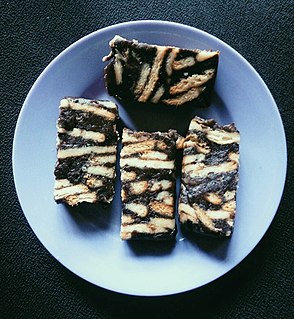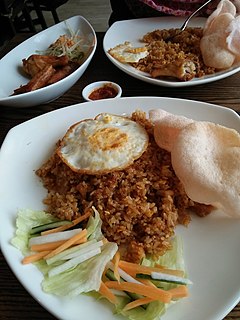 W
WBruneian cuisine concerns the cuisine of Brunei. It is similar to, and heavily influenced by the cuisine of neighbouring Malaysia, Singapore, and Indonesia, with additional influences from India, China, Thailand, and Japan. As is common in the region, fish and rice are staple foods, though beef is expensive and thus less common. Due to the predominance of the Islamic religion, the food is halal and pork is avoided. Alcohol is banned in Brunei. In rural areas, game animals such as wild birds, sambar deer, and barking deer are hunted.
 W
WMalay cuisine is the traditional food of the ethnic Malays of Southeast Asia, residing in modern-day Malaysia, Indonesia, Singapore, Brunei, Southern Thailand and the Philippines as well as Cocos Islands, Christmas Island, Sri Lanka and South Africa.
 W
WAcar is a type of vegetable pickle of Maritime Southeast Asia, most prevalent in Indonesia, Malaysia, Singapore and Brunei. It is a localised version of Indian achar. It is known as atjar in Dutch cuisine, derived from Indonesian acar. Acar is usually prepared in bulk as it may easily be stored in a well-sealed glass jar in refrigerator for a week, and served as the condiment for any meals.
 W
WAis kacang, literally meaning "bean ice", also commonly known as ABC and ABC冰 (acronym for air batu campur, meaning "mixed ice", or ice kacang, is a dessert which revolves around shaved ice.
 W
WAmbuyat is a dish derived from the interior trunk of the sago palm. It is a starchy bland substance, similar to tapioca starch. Ambuyat is the national dish of Brunei, and a local specialty in the Malaysian states of Sarawak, Sabah, and the federal territory of Labuan, where it is sometimes known as linut.
 W
WApam balik, also known as terang bulan, martabak manis or mànjiānguǒ, is a dessert common in many varieties at specialist roadside stalls throughout Brunei, Indonesia, Malaysia and Singapore.
 W
WBahulu or baulu is a traditional Malay pastry (kue/kuih). It is similar in concept to the madeleine cake, but round in shape and composed of different ingredients. There are three versions available, the most common being bahulu cermai (star-shaped) and the more elusive bahulu gulung and bahulu lapis (layered). Bahulu is believed to be originated in Malay Peninsula during the colonization era and is the corruption of the Malaccan Kristang word, bolu which means cake. It is usually served during Eid al-Fitr as well as during the Chinese New Year.
 W
WBandung, sirap bandung, air bandung or iced bandung is a drink popular in Maritime Southeast Asia, notably in Brunei, Malaysia and Singapore. It consists of evaporated milk or condensed milk flavoured with rose syrup, giving it a pink colour.
 W
WBatik cake is a type of Malaysian fridge cake dessert inspired by the tiffin, brought in the country by the British during the colonial era, and adapted with Malaysian ingredients. This cake is made by mixing broken Marie biscuits combined with a chocolate sauce or runny custard made with egg, butter/margarine, condensed milk, Milo and chocolate powders. The cake is served during special occasions like the Eid al-Fitr and Christmas.
 W
WCendol is an iced sweet dessert that contains droplets of green rice flour jelly, coconut milk and palm sugar syrup. It is commonly found in Southeast Asia and is popular in Indonesia, Malaysia, Brunei, Cambodia, East Timor, Laos, Vietnam, Thailand, Singapore, and Myanmar. Next to the green jelly, additional toppings might be added, including diced jackfruit, sweetened red azuki beans, or durian.
 W
WCincin is a traditional kuih for the Bruneian Malay people in the states of Sabah, Malaysia as well in Brunei.
 W
WClorot, celorot, cerorot, or jelurut is an Indonesian traditional sweet snack of sweet and soft rice flour cake with coconut milk, wrapped with janur or young coconut leaf in cone shape. It is a popular traditional sweet snack commonly found in Indonesia, Malaysia and Brunei.
 W
WCoconut jam, also known as kaya jam, is a sweet spread made from a base of coconut milk, eggs and sugar. It is popular throughout Southeast Asia.
 W
WA curry puff is a snack of Maritime Southeast Asian origin. It is a small pie consisting of curry with chicken and potatoes in a deep-fried or baked pastry shell. The curry is quite thick to prevent it from oozing out of the snack.
 W
WGinger tea is a herbal beverage that is made from ginger root. It has a long history as a traditional herbal medicine in East Asia, South Asia, Southeast Asia and West Asia.
 W
WGrass jelly, or leaf jelly or herb jelly, is a jelly-like dessert eaten in East and Southeast Asia. It is created by using the Platostoma palustre plant and has a mild, slightly bitter taste. It is served chilled, with other toppings such as fruit, or in bubble tea or other drinks. Outside Asia, it is sold in Asian supermarkets.
 W
WJala is a traditional kuih from Sabah and Sarawak in Malaysia and Brunei. In Sarawak, it is known as the traditional snack for the Iban people. It is very different from the roti jala in Peninsular Malaysia.
 W
WJemput-jemput or cekodok is a traditional fritter popular in Indonesia, Brunei, Malaysia and Singapore that is made from wheat flour. It is usually round in shape and tends to vary in size. There are many varieties of this snack, some using banana, anchovies or prawns, onion or maize.
 W
WKelupis is a traditional kuih for the Bruneian Malay people in the country of Brunei and in the states of Sabah and Sarawak in Malaysia. It is also a traditional snack for the Bisaya people as the three ethnics are ethnically related which is Lun Bawang/Lundayeh also create this kelupis especially on the wedding ceremony.
 W
WKetupat, kupat or tipat is a Javanese rice cake packed inside a diamond-shaped container of woven palm leaf pouch, Originating in Indonesia, it is also found in Brunei, Malaysia, Singapore and southern Thailand. It is commonly described as "packed rice", although there are other types of similar packed rice such as lontong and bakchang.
 W
WKue kochi or koci is a Maritime Southeast Asian dumpling found in Javanese, Malay and Peranakan cuisine, made from glutinous rice flour, and stuffed with coconut fillings with palm sugar.
 W
WKue makmur is a traditional Malay kue or kuih. This cake made from butter, ghee and flour, and served during special occasion of Eid al-Fitr. Kue makmur is identified with its white colour and usually in a round shape.
 W
WKue semprong, Asian egg roll, sapit, sepit, kue Belanda, or kapit, is an Indonesian traditional wafer snack made by clasping egg batter using an iron mold which is heated up on a charcoal stove. It is commonly found in Indonesia, Malaysia, Singapore and Brunei.
 W
WLamban is a traditional dessert for the Bruneian Malay people, Kedayan in Labuan and in the states of Sabah, Malaysia. The taste of Lamban is almost like the Malays ketupat or the Chinese's rice dumplings and kelupis of Lun Bawang / Lundayeh.
 W
WKuih lidah is a traditional kuih for the Bruneian Malay people in Papar in the states of Sabah in Malaysia.
 W
WMurtabak is a stuffed pancake or pan-fried bread which is commonly found in the Arabian Peninsula and Southeast Asia, notably in Saudi Arabia, Kuwait, Yemen, Indonesia, Malaysia, Singapore, Brunei, and Thailand. Depending on the location, the name and ingredients can significantly vary. The name mutabbaq in Arabic means "folded". It is a popular street food in Indonesia, Malaysia, and Singapore.
 W
WNasi goreng is a Southeast Asian fried rice dish, usually cooked with pieces of meat and vegetables. One of Indonesia's national dishes, it is also endemic in Malay-speaking communities in countries such as Malaysia, Singapore and Brunei, and has gained popularity in Sri Lanka through migrations from the Malay Archipelago, in countries like Suriname via Indonesian immigrant communities, and in the Netherlands through its colonial ties with Indonesia. Nasi goreng is distinguished from other Asian fried rice preparations by its distinct smoky aroma, and caramelised yet savoury undertones of flavour. There is no single defined recipe for nasi goreng, and its composition and preparation varies greatly from household to household.
 W
WPinjaram, also known as penyaram, kuih UFO or kuih telinga tikus is a traditional kuih for the Bajau as well for the Bruneian Malay people in Brunei and in the state of Sabah in Malaysia.
 W
WPisang goreng is a fritter made by deep frying battered plantain in hot oil. It is popular in Indonesia, Malaysia, Singapore, and Brunei. It is typically consumed as a snack in the morning and afternoon. In Indonesia and Malaysia, pisang goreng is often sold by street vendors, although it is also offered as a product at storefronts and dining establishments.
 W
WRendang is a Minang dish originating from the Minangkabau region in West Sumatra, Indonesia. It has spread across Indonesian cuisine to the cuisines of neighbouring Southeast Asian countries such as Malaysia, Singapore, Brunei and the Philippines. Rendang is often described as a rich dish of meat — most commonly beef — that has been slow cooked and braised in a coconut milk seasoned with a herb and spice mixture, until the liquids evaporate and the meat turns dark brown and tender, becoming caramelized and infused with rich flavours.
 W
WRoti bakar refers to toast, usually prepared with grilled white bread, in both the Indonesian and Malay languages. The dish is a popular breakfast food as well as tea time snack in countries like Brunei, Indonesia, and Malaysia. Historically, roti bakar was grilled or toasted by using charcoal as a heat source in many communities throughout the region, though this practice has dwindled with the advent of modern technology.
 W
WTapai, is a traditional fermented preparation of rice or other starchy foods, and is found throughout much of Southeast Asia, especially in Austronesian cultures, and parts of East Asia. It refers to both the alcoholic paste and the alcoholic beverage derived from it. It has a sweet or sour taste and can be eaten as is, as ingredients for traditional recipes, or fermented further to make rice wine. Tapai is traditionally made with white rice or glutinous rice, but can also be made from a variety of carbohydrate sources, including cassava and potatoes. Fermentation is performed by a variety of moulds including Aspergillus oryzae, Rhizopus oryzae, Amylomyces rouxii or Mucor species, and yeasts including Saccharomyces cerevisiae, and Saccharomycopsis fibuliger, Endomycopsis burtonii and others, along with bacteria.
 W
WTeh tarik is a popular hot milk tea beverage most commonly found in restaurants, outdoor stalls, mamaks and kopitiams within the Southeast Asian countries of Malaysia, Indonesia and Singapore. Its name is derived from the pouring process of "pulling" the drink during preparation. It is made from a strong brew of black tea blended with condensed milk. It is the national drink of Malaysia.
 W
WThali or Bhojanam is a round platter used to serve food in South Asia and Southeast Asia. Thali is also used to refer to an Indian-style meal made up of a selection of various dishes which are served on a platter.
 W
WWajik or wajid is an Indonesian diamond-shaped kue or traditional snack made with steamed glutinous (sticky) rice and further cooked in palm sugar, coconut milk, and pandan leaves. The sweet sticky rice cake is commonly found in Indonesia, Malaysia and Brunei. It is called wajid in Brunei and Sabah.